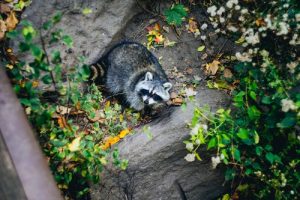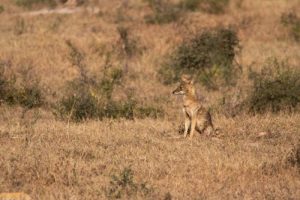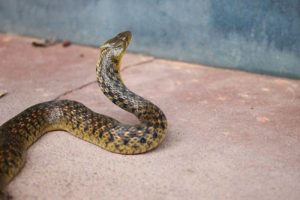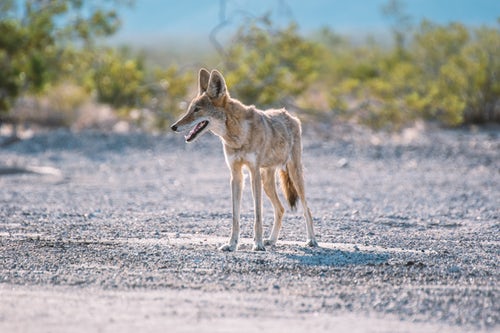In Stapleton, it’s not difficult to like your neighbors. And, one of our neighbors is the Rocky Mountain Arsenal National Wildlife Refuge. One of the largest urban wildlife refuges, its 15,000 acres of pristine prairies and lakes are home to an abundance of wildlife. More than 280 species of birds, bull snakes, bison, coyotes, deer, raccoons, and many other mammals are attracted to the refuge. And, with this abundance of wildlife, there’s naturally some overflow into our neighborhood. In fact, many of us have stumbled upon a raccoon, coyote, or bull snake while taking a stroll with the family dog. Many misconceptions surround these critters, but understanding them will help prevent any mishaps.
Raccoons
 These “masked bandits” can get into mischief anywhere they go. Their best sense is touch, and they love to pick up all sorts of objects to closely examine. Raccoons can handily get into your trash, open doors, and cause mayhem as they search for food. Being omnivores, they enjoy insects, eggs, small mammals, fruit, berries, seeds, and your garbage. Because they have a sensitive sense of touch, they dunk their food in water before eating it, which helps to increase that sensitivity and give them better information on their food choices.
These “masked bandits” can get into mischief anywhere they go. Their best sense is touch, and they love to pick up all sorts of objects to closely examine. Raccoons can handily get into your trash, open doors, and cause mayhem as they search for food. Being omnivores, they enjoy insects, eggs, small mammals, fruit, berries, seeds, and your garbage. Because they have a sensitive sense of touch, they dunk their food in water before eating it, which helps to increase that sensitivity and give them better information on their food choices.
If you leave food and water bowls for your pup on your patio overnight and a raccoon finds them, chances are you will spend your morning cleaning up your outdoor space. Raccoons are messy eaters, scattering kibble and leaving puffy pieces behind in the water dish. Prevent your home from becoming a raccoon restaurant by bringing pet food inside at night and confirming that all trash is secure.
Coyotes
Just like our raccoon friends, coyotes are omnivores. They love to make meals of rabbits, rodents, antelope, lizards, birds, cactus fruits, and flowers. Coyotes aren’t picky: They will also eat dead carcasses and garbage if necessary.
 These 20- to 50-pound canines have an incredible sense of hearing and smelling, and they have the ability to walk silently on the tips of their toes to avoid predators and stalk their prey. With all these handy skills necessary for survival, they thrive in outlying urban areas as their natural habitats are being encroached upon more and more.
These 20- to 50-pound canines have an incredible sense of hearing and smelling, and they have the ability to walk silently on the tips of their toes to avoid predators and stalk their prey. With all these handy skills necessary for survival, they thrive in outlying urban areas as their natural habitats are being encroached upon more and more.
In Stapleton, we can easily see coyotes slinking around trashcans or chasing rabbits at dawn and dusk, so use caution when letting small dogs or cats outside, especially in dim lighting and if your home is facing one of Stapleton’s open spaces. Most coyotes won’t come into a yard to snatch a pet, but as Stapleton continues to expand and more homes are built where these animals live and hunt for food, we need be diligent about keeping our pets safe.
Bull Snakes
Another common resident of the nearby refuge, bull snakes are often confused with rattlesnakes. The flattening of its head, S-shaped strike stance, loud hissing sound, movement of its tail, and fierce aggression of the bull snake can be terrifying. Unlike the rattlesnake, this species is non-venomous, so relying on these intimidation factors is its best defense.
 Imitating the rattlesnake in looks as well, bull snakes are usually yellow in color and have brown, yellow, or black marks on their skin. Like all constrictors, they are skilled in controlling the vermin population, preferring to make a meal of rodents, rabbits, gophers, ground squirrels, frogs, lizards, and ground-dwelling birds and their eggs.
Imitating the rattlesnake in looks as well, bull snakes are usually yellow in color and have brown, yellow, or black marks on their skin. Like all constrictors, they are skilled in controlling the vermin population, preferring to make a meal of rodents, rabbits, gophers, ground squirrels, frogs, lizards, and ground-dwelling birds and their eggs.
Unlike raccoons and coyotes, these scaly creatures prefer the day, except when the temperatures rise high enough to push them into nighttime activities.
Use caution if you encounter a raccoon, coyote, or bull snake
Raccoons and coyotes can carry rabies, leptospirosis, and canine distemper, three diseases that have vaccinations available.
In 2018, Denver county has seen a steep increase in rabies cases, from 20 animals that tested positive in 2017 to 60 so far this year. If you notice an animal acting odd or that appears to be injured, call 311 and keep all pets and children away. Due to this rapid surge in rabies victims in our area, it is crucial to make sure your pet is vaccinated.
In addition to rabies, leptospirosis, and distemper, raccoons can also transmit roundworms to people and dogs. This scary parasite can travel to your eyes, brain, and other organs causing loss of muscle control, blindness, and possibly leading to a coma.
With more than one acre of green space for every person living in Stapleton, there is plenty of room to live side-by-side with nature. Respect the animals and understand that they can be dangerous if cornered. Armed with this knowledge, peacefully coexisting with our native wildlife should be a cinch.




